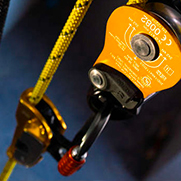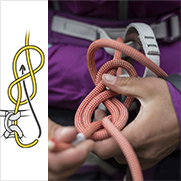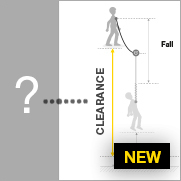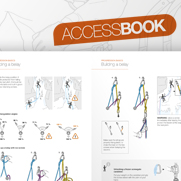Information: using Petzl CROLL L B16 & B16AAA in corrosive environments
This information is intended specifically for those who use the Petzl CROLL L rope clamp intensively for professional use. This update follows the information released on the Petzl website on March 17, 2014.
April 2 2014
Archive
Go to :
Review of the facts
As explained in our previous communiqué posted on the Petzl website on March 17, 2014, two different customers have informed us of recent failures of the rivet head on two Petzl CROLL L rope clamps; neither failure led to an accident. These two CROLL L rope clamps were used on offshore platforms in the North Sea. There was no sign of specific wear or damage on either CROLL L prior to the failures.
Research of potential causes
Material analysis of the rivets
Procedure: Vickers hardness tests were performed at the surface and on the cross-section of the rivets in question.
Results: The results of these tests are within our technical specifications.
Procedure: Chemical analysis of the rivet
Results: In addition to the steel elements (C+Fe+Cr), we observed the presence of calcium (Ca), magnesium (Mg), sodium (Na), and chlorine (Cl) (all present in salt water) from the work environment.
(Chemical analysis of the broken rivet)
Corrosion analysis:
Procedure: Micrographic observations in the longitudinal axis of the rivet. Magnification from x50 to x200.
Results: Corrosion pitting is visible all along the body of the rivet.
Magnification = x50 Magnification = x200 Magnification = x200
(Micrographic images of the broken rivet show corrosion cracks)
Profile of the breaking surface:
1st visual profile = fatigue failure mode in the periphery of the fracture surface:
Procedure: Scanning Electron Microscope (S.E.M) to observe the fracture surface.
Results: We observed the presence of fatigue crack propagation.
As with any CROLL L-type device, during each stroke, sudden dynamic loading is produced when the user’s body weight is applied to the rope clamp. On other rope clamps, like an ASCENSION, the loading is more gradual. This sudden dynamic loading in combination with the “yo-yo” effect can lead to dynamic forces of up to 2.5 kN. The rope clamp is subjected to cyclic loading ranging from 0 kN to 2.5 kN. The combination of this cyclic loading and the corrosion pitting led to an initial fracture surface typical of cracks that spread through fatigue.
(S.E.M. images of the fracture surface show fatigue crack propagation)
2nd visual profile = brittle failure mode in two thirds of the breaking surface:
Procedure: Scanning Electron Microscope to observe the fracture surface.
Results: Examination revealed the kind of cleavage faces that are a characteristic feature of brittle failure mode.
This also confirms the sudden nature of the failure. About two thirds of the breaking surface show a perfectly "smooth" cleavage associated with secondary cracks, and denote brittleness in fracture. We can conclude that the final failure was due to a sudden overloading of the already damaged rivet.
(S.E.M. image of the fracture surface shows the kind of cleavage faces that are a characteristic feature of brittle failure mode)
Fatigue tests:
Procedure: Cyclic loading tests have been conducted in our laboratory to replicate the service conditions (except the presence of corrosion) in an attempt to reproduce this failure. A 100 kg cyclic load is applied to the CROLL L.
Results: The CROLL L body fails before any damage to the rivet is observed. To date, it has not been possible to replicate the two failures observed in the field.
(Cyclic loading tests with a 100 kg mass)
Conclusions
The most probable hypothesis is that the rivet head failed due to a combination of 3 factors:
- Initiation: Corrosion (offshore platform) => Use in a marine environment initiated corrosion pitting on the body of the rivet and under the rivet head in a non-visible area.
- Propagation: Cyclic loading => The rope clamp is subjected to cyclic loading ranging from 0 kN to 2.5 kN, which propagated fatigue cracks from the corrosion pit zones.
- Failure: Fatigue cracks became large enough to lead to a complete, sudden failure.
Conclusions
Observations
- Historically, Petzl PPE has frequently been used in corrosive environments (e.g. marine environments, the presence of petrochemicals, etc.), and experience shows us that this generally does not create issues.
- However, under certain conditions, the lifetime of the product may sometimes greatly be reduced due to corrosion phenomena especially if the use of the PPE is predominantly in a corrosive environment. See excerpt from the technical notice below:
- Additionally, corrosion of stainless steels (all stainless steels corrode) is difficult to detect, because it develops through a process of micro-cracks barely detectable to the human eye. The detection of the corrosion of stainless steels is more difficult when the component is in a confined area.
- Reinforcing the corrosion resistance of our PPE to withstand severe environments (e.g. marine environment, petrochemicals, etc.) would require the use of High Corrosion Resistance (HCR) stainless steels, which have lesser mechanical properties, including lower mechanical strength. Consequently, this would require a significant increase in the size of the PPE so that it could meet the standard requirements and usage constraints. Furthermore, the aluminum body may not be resistant enough to withstand the corrosion constraints of such environments. Thus, a piece of PPE made to be “corrosion-proof” in such environments would require an entirely new product design.
Conclusions
Petzl PPE is not designed to be "corrosion-proof". However, the use of Petzl PPE in highly corrosive environments (e.g. marine environments, petrochemicals, etc.) is possible, under certain conditions:
- It requires greater vigilance and more regular periodic inspection.
- It requires more frequent maintenance.
- Its lifetime can be greatly reduced.
- The user’s risk analysis should incorporate the specific risk of corrosion of materials in corrosive environments.
Petzl operational recommendations
The frequency of this in-service failure of the CROLL L is exceptionally low (two in hundreds of thousands). However, Petzl recommends:
- 4-1: When used in a corrosive environment, rinse and dry any Petzl metallic PPE after each use in order to limit potential corrosion issues (particularly in the hidden/confined areas).
- 4-2: In accordance with existing Petzl recommendations, when connected to a rope clamp, the user must have a backup device or a connection to a second rope clamp (secondary means of support).
- 4-3: Users visually inspect their CROLL L B16 & B16AAA to check that the rivet head is not missing.
Petzl requests that this information be made available to all those who work with, maintain, and inspect Petzl CROLL L rope clamps, and strongly suggests that the recommendations listed above be put into effect.
FAQ
- Does this affect all of the previous CROLL L versions?
The two devices with a broken rivet head are the previous version of the CROLL L (B16 and B16AAA). Petzl recommendations 4-1 and 4-2 apply to any Petzl rope device. Petzl recommendation 4-3 applies to all of the previous version of the CROLL L (B16 and B16AAA).
- Does this affect the new, smaller CROLL L B16BAA?
As a precautionary measure, Petzl recommendations 4-1, 4-2, 4-3 apply also to the new, smaller CROLL L B16BAA.
- I use my CROLL L in a non-marine environment; do I need to carry out this inspection?
As a precautionary measure, we recommend that you perform this inspection because you may be in a corrosive environment, such as in the presence of petrochemicals.
- How do I check the rivet head?
Just visually check that the rivet head is still intact.
- If the rivet head is intact, can I continue to use my CROLL L?
Yes, you may continue to use your CROLL L in accordance with the technical notice and continue to inspect it in accordance with Petzl’s recommendations at www.petzl.com/en/ppe-checking.
- What should I do if the rivet head on my CROLL L is missing or damaged?
Your CROLL L must immediately be retired, and we ask that you please contact your local distributor/agent.
- If the rivet head were to fail during use, what is the likely outcome?
If your system is under tension nothing will happen, but as soon as the tension is released, you may lose the rivet and your CROLL L will not lock any more.
- Have there been any reported accidents/injuries as a result of these rivet failures?
NO accidents have been reported to us.
For more information, please contact your local distributor.








